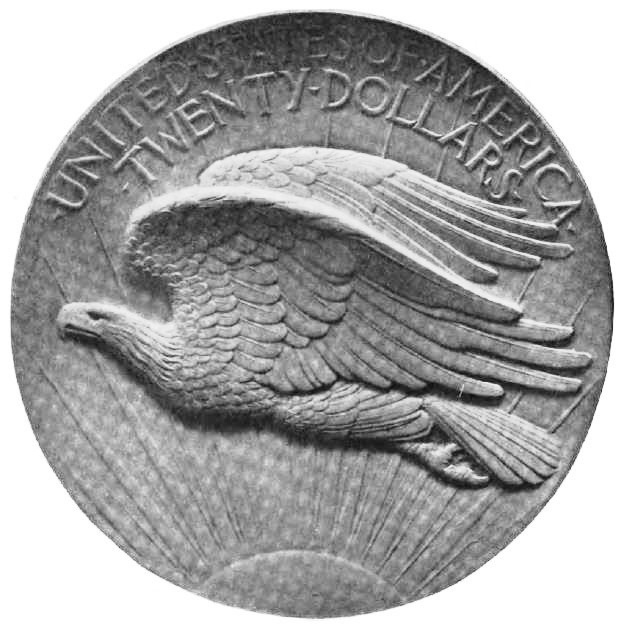
Here is a rough table of some values for gold, and the relative value of a dollar in terms of gold under those values:
-1834 -1933 -1971 2011
Up to 1834: $19.38 $1.00 $1.07 $1.81 $81.80
Up to 1933: $20.67 94¢ $1.00 $1.69 $76.69
Up to 1971: $35.00 55¢ 59¢ $1.00 $45.29
January 21, 1980 $850.00 2.28¢ 2.43¢ 4.12¢ $1.86
April 2, 2001 $255.95 7.57¢ 8.08¢ 13.67¢ $6.19
July 13, 2011: $1,585.20 1.22¢ 1.3¢ 2.2¢ $1.00
The peak high in 1980 (New York), the peak low in 2001 (London), and the new record-setting price (New York) are noted.
People writing mediaeval role-playing games should note that due to the difference in density between gold and silver, if one uses the historic ratio that gold is 16 times more valuable than silver by weight, then it is also (approximately) 25 times more valuable than silver by volume. This will make it possible to determine more accurately how much treasure your characters can carry in their backpacks, while still using handy round numbers.
Prior to the devaluation of the U.S. dollar in 1933, which also led to the abolishment of gold coinage, according to one source the U.S. dollar was defined by defining the Gold Eagle, a coin with a denomination of $10, as being composed of 258 grains of 9/10 fine gold. In U.S. gold coins, the remaining tenth was originally made up of half silver and half copper, which were not without value themselves; however, shortly after the standard of interest was adopted in 1837 they switched to using only copper for the remaining tenth: this happened for the eagle in 1838, the half eagle in 1839, and the quarter eagle in 1840.
The Coinage Act of 1834, passed on June 28, 1834, affected the content of U. S. gold coins by changing the ratio in the value, by weight, of gold to that of silver from 15 to 1 to 16 to 1. At that point, the Constitutional definition of the dollar as the value of 371.25 grains of silver remained unchanged, and so the dollar changed from having the value of 24.75 grains of gold to having the value of 23.203125 grains of gold. A troy ounce of gold having 480 grains, this means that the price of a troy ounce of gold changed from $19.3939393939... to $20.6868241092005727664425... before being changed again to $35 on April 5, 1933 by Executive Order 6102. However, gold turned in pursuant to that order prior to May 1, 1933 was paid for at the rate of $20.67 per troy ounce, leading to this being the most commonly used figure for the old value of gold.
The Constitution originally defined the dollar as 371.25 grains of silver, and that is 90% of 412.5. In 1872, the weight of the silver dollar was reduced to 384 grains of 9/10 fine silver, because the price of silver had gone up again relative to that of gold, and gold was generally accepted as the international standard of monetary value. However, unlike the previous silver dollar, while this coin was still intended to be worth nearly a dollar, it was not expected to be worth exactly a full dollar; it was not token coinage, but it was subsidiary coinage.
If the situation between 1834 and 1872 is used as the basis, then, an attempt can be made to determine the exact nominal value of pure gold in U.S. dollars.
A gold dollar of 25.8 grains of 9/10 fine gold consists of 23.22 grains of pure gold, 1.29 grains of pure silver, and 1.29 grains of copper.
371.25 grains of pure silver and 41.25 grains of copper equal a dollar.
Thus, 1.29 grains of pure silver and 0.14333... grains of copper equal 0.3474747... cents.
So, 23.22 grains of pure gold and the remaining 1.15333... grains of copper equal 99.6525252... cents; thus, if we neglect the value of the copper, that works out to one troy ounce of gold (480 grains) being worth almost exactly $20.60 instead of $20.67.
If silver were worth 1/16th as much as gold, this would make 371.25 grains of silver worth about 99.58 cents instead of a dollar.
In 1805, the price of copper was considered high at 138 pounds a ton, or about $690 a ton. A ton being 2000 avoirdupois pounds of 7000 grains, this would be about 2.366 cents per troy ounce, compared to about $1.29 per troy ounce for silver and $20.60 per troy ounce for gold. Thus, the ratio of value by weight, historically, had been in the neighborhood of 50 to 1 between silver and copper, or perhaps higher.
In 1880, the price of copper peaked at 20 1/8 cents a pound (which I assume to be an avoirdupois pound); that price would work out to 1.38 cents per troy ounce, which is even lower, indicating a 100 to 1 ratio between silver and copper as a possible historical normal.
Given the composition of the Gold Eagle above, a half-eagle, with a $5 denomination, would be composed of 116.1 grains of pure gold, 6.45 grains of pure silver, and 6.45 grains of pure copper. A Gold Sovereign from Britain, on the other hand, is composed of 113.0015 grains of pure gold, and 10.2729 grains of copper, for a total weight of 123.2744 grains, or 7.9881 grams. Another source gives the weight of a British Gold Sovereign as 5 pennyweights, 3 171/623 grains; one pennyweight is 24 grains, so this is 123 171/623 grains, or approximately 123.2744783306581 grains. This works out to about 113.0016 grains of pure gold at 22 carats.
Of course, there is the matter of seigniorage; stamping out metal into coins, after all, costs money, so one would not expect the metallic content of coins, even when they are not a token or subsidiary coinage, to absolutely equal their value. I have not been able to find an admission that the United States engaged in such a practice, however; but one reference, which directly states that Britain did not have seigniorage either, then goes on to say that the mint price of gold there is 3 pounds, 17 shillings, and 10 1/2 pence per troy ounce, and that the Bank of England buys bullion at 3 pounds, 17 shillings, and 9 pence per troy ounce. I would take the 1 1/2 pence difference as the (very nominal!) seigniorage; that is, that gold is worth 3 pounds, 17 shillings, and 9 pence per troy ounce, but gold coins are denominated as if gold were very slightly more valuable.
If the halfpenny were exactly equal to the cent, making the British pound equal to $4.80 in value, 113 grains of gold to the pound would imply about 117.7 grains of gold to five dollars; thus, while a pound was not worth quite as much as five U.S. dollars, it was actually worth about $4.85 at the time of the gold standard. (Actually, the value of the mint par of exchange used at the time was $4.8665.) While the Canadian dollar was made to be equal to the U.S. dollar, the Newfoundland dollar was about 1 1/3 cents more than a U.S. dollar, as one would expect from a dollar equal to 100 ha'pennies.
With 116.1 grains of pure gold in a $5 half eagle, divided by five, being 23.205 grains per dollar, and 500/480 times 113.0016 grains of pure gold, divided by five, being 23.542 grains per Newfoundland dollar, it may also be noted that a Mexican 10 peso coin contained 7.5 grams of pure gold; this works out to 115.7427 grains of pure gold, thus, the Mexican 50 peso coin does not have exactly the same amount, but instead has slightly less, gold than a $25 U.S. gold coin would have: thus, two Mexican pesos would have been worth about 3/10 of a cent less than a U.S. dollar.
However, a metric dollar worth 1.5 grams of gold, even if slightly smaller than the pre-1933 dollar, is certainly attractive as involving round numbers.
In that era, other countries also had currencies which were fixed in value in terms of gold, and thus to one another. Thus, 19.2952 cents, at 4.48036 grains of gold, or 0.290322581 grams of gold, was the value of a French Franc, a Swiss Franc, a Belgian Franc, an Italian Lira, a Bulgarian Lev, or a Greek Drachma in those days; this was the standard fixed by the Latin Monetary Union. An American gold pattern coin, the Stella, denominated as a four dollar coin, was made to approximate the specifications of a 20 Franc gold coin (the coin commonly referred to as a Gold Napoleon, for Sherlock Holmes fans). Also, Austria-Hungary issued 4 and 8 Gulden coins which matched the specifications of 10 and 20 Franc coins.
There was also a Scandinavian Monetary Union during the same period, where the Danish Krone, the Swedish Krona, and the Norwegian Krone were valued so that 36 Kronor would equal 50 Francs, with both being approximately equal to 2 British Pounds. Note that a British Pound was closer to $4.80 in those days than to $5.
Finland was a member of the LMU rather than the SMU. Peru, Colombia, and Venezuela were also part of the LMU: the Venezuelan Bolivar was equivalent to 1 Franc, the Peruvian Sol and the Venezuelan Peso were each equivalent to 5 Francs
The Finnish Markka. when introduced in 1860, was originally defined as 1/4 of the Russian Ruble. This corresponded well to the definition of the Russian Ruble in 1885 as being equivalent to 4 French Francs, but in 1897 the Russian Ruble was devalued to 2 2/3 Francs, so 8 Francs would equal 3 Rubles.
Neither Germany nor Portugal was a part of either of these monetary unions. The German Empire did not issue gold coins, but the individual German states had done so; thus, a 20 Mark coin weighed 7.965 grams, was composed of 900 fine gold, and thus contained 0.2305 troy ounces of fine gold, whether from Wurttemburg, Schleswig-Holstein, Schaumburg-Lippe, Saxe-Meiningen, Saxe-Weimar-Eisenach, or Saxony-Albertine, and so on, thus making the German Mark worth about 1.23 French Francs. A Portuguese Coroa was worth slightly more than 40 Kronor.
A proposal for an international currency, called the spesmilo (and with the plural spesmiloj, the proposal being advanced by proponents of the international language Esperanto), divided into one thousand spesoj, having a value of 11/12 of that of 0.8 grams of gold was advanced in 1907 by René de Saussure, and some banks, in Britain, Switzerland, and Czechoslovakia handled the currency, and there were coins minted which were denominated in it.
One problem with the Latin Monetary Union was that, at its inception, it was based on bimetallism: that is, silver coins were standardized as well, and were to be accepted by other countries based on their metal content. And this was based on a ratio where gold was worth 15.5 times as much as silver by weight, favoring silver even more than the "historic" 16 to 1 ratio that was also high even for the period prior to 1933.
Today, as I write this, gold is $1,257.40 per troy ounce, and silver is $16.07 per troy ounce, for a ratio of almost 78.25 to 1. I suppose I should not be surprised. Silver is no longer in demand for coinage; it is no longer in demand for photography - while black-and-white photography consumed silver, it was largely recoverable in the case of color photography, but then instant cameras consumed silver again, but now, of course, silver is no longer involved when CCD (and CMOS) sensors are used; and it is no longer in demand for tableware, given all the sulphur in the air these days. Nor, for that matter, is silver particularly fashionable for jewellery, perhaps for the same reason.
The price of gold, of course, is volatile these days. Since an 80:1 ratio between the price of gold and silver is five times the historic ratio, though, if gold and silver coins were minted according to that value, then if the dollar was defined in terms of the pre-1933 value of gold, but divided into 1000 mills, instead of 100 cents, then in addition to having a half-eagle, an eagle, and a double wagle, and perhaps also a quarter-union as gold coins, the silver coins could be 20 mills (the size of a dime), 25 mills (the size of a sixpence), 50 mills (the size of a quarter) and 100 mills (the size of a half-dollar)... and both 200 mills (the size of a silver dollar) and 250 mills (the size of a crown).
While there are great amounts of gold dissolved in the oceans, and along with platinum and iridium, gold is to be found in asteroids, I don't know of any science-fictional massive sources of silver beyond the horizon, though.
The St. Gaudens $20 Double Eagle gold coin, the last type of regularly circulating $20 gold coin in the United States, is regarded as one of the most beautiful coins ever made. Originally, the ultra-high relief version was only made as a proof, of which about twenty specimens are believed to exist.
Here are photographs, from an old book from 1907, and hence in the public domain, of the original plaster casts which Augustus Saint-Gaudens made of his initial design:

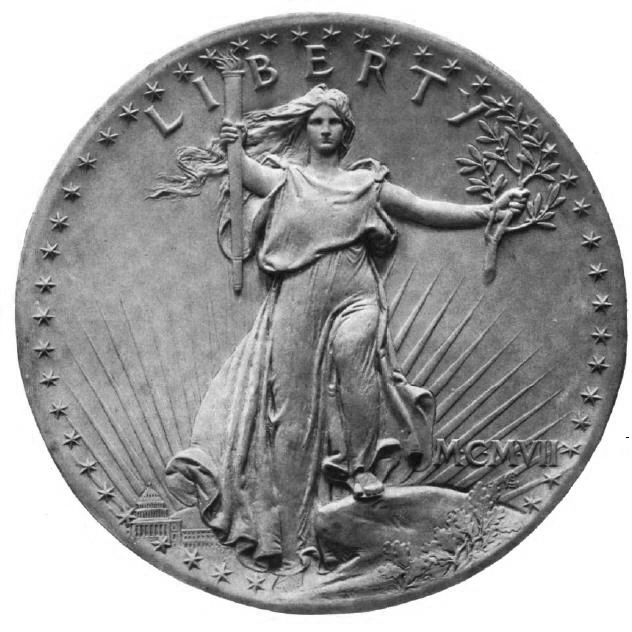
In the first year of issue, what was actually minted initially was a more practical, but still high-relief, version, with the date of 1907 in Roman numerals; about 12,000 were minted, they were released into circulation in both 1907 and 1908. While the original ultra-high relief version was difficult to stack, and hence felt to be impractical as a coin, and a somewhat lower-relief version submitted by the artist was still not practical, even the more moderate high-relief version designed under the closer direction of the Mint from St. Gaudens' original by another artist proved difficult to strike, however.
Here is an image of the 1907 high-relief coin as minted, for comparison:
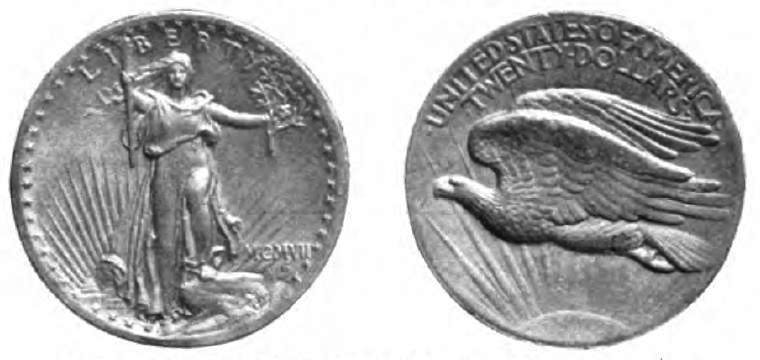
Therefore, before the end of 1907, the low-relief version of the coin was designed and minted, which continued in use until 1932; thus, for 1907, both versions of the coin exist, and even for the date 1907, those of low relief far outnumber the high-relief ones.
For comparison, here is an image of the low-relief version of the Double Eagle:
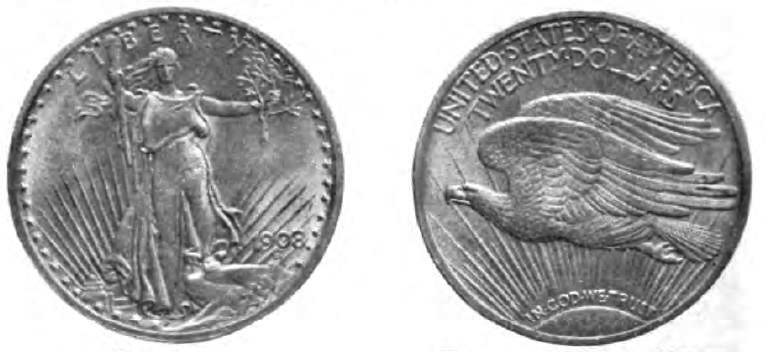
In 2009, close to the 100th anniversary of the introduction of the St. Gaudens Double Eagle coin, just two years late, the United States Mint offered for sale a 2009 coin, denominated as twenty dollars, following the ultra high relief style.
This special coin was made of pure gold, rather than 900 fine gold. Also, it was only 27mm in diameter, the same diameter as a $10 Eagle rather than the usual 34 mm diameter of a $20 Double Eagle. However, it weighed 31.109 grams, so this merely meant it was thicker; it still had the same gold content as one of the Double Eagles of the past.
As the U.S. Mint is a branch of the U.S. Government, I am able to include here high-quality images of this coin:
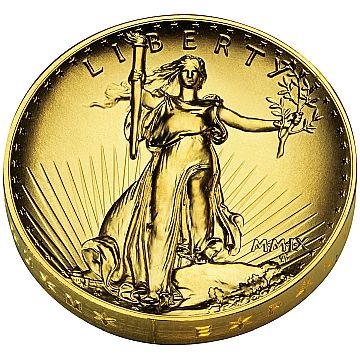
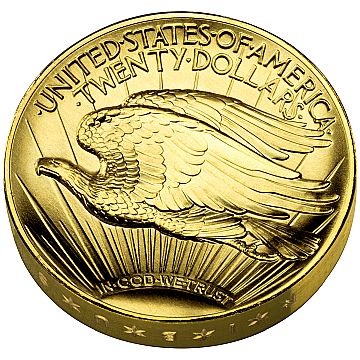
Incidentally, note that in one particular, this coin resembles the low-relief version of the coin rather than the high-relief version. The first U.S. coins to bear the motto "In God We Trust" were minted in 1864; when the high-relief St. Gaudens gold coins came out in 1907 without that motto, this was sufficiently shocking that Congress afterwards enacted a formal legal requirement for that motto to appear on U.S. coinage.
Other possibilities for the basis of a standard value for the dollar might be the Maria Theresa thaler, containing 5/6ths of 28.0668 grams of fine silver, which is exactly 23.389 grams, the Reichsthaler of the Holy Roman Empire with 400.99 grains (25.984 grams) of fine silver, which followed closely on the original Joachimsthaler, but which became the coin of account for the entire German Empire.
Here is a rough table of coin diameters and values, where the values are in terms of the value of U. S. currency in precious metals between 1892 and 1933, and the upper value is for silver coins, the lower for gold coins:
13mm 15mm 16mm 17mm
4 5 6 1/4 7 13/16
$1.00 $1.25 $1.56 1/4 $2.45 5/16
17mm 18mm 19mm 20mm
8 10 12 1/2 15 5/8
$2.00 $2.50 $3.12 1/2 $3.90 5/8
20mm 22mm 24mm 26mm
16 20 25 31 1/4
$4.00 $5.00 $6.25 $7.81 1/4
26mm 28mm 31mm 33mm
32 40 50 62 1/2
$8.00 $10.00 $12.50 $15.62 1/2
33mm 35mm 38mm 41mm
64 80 $1.00 $1.25
$16.00 $20.00 $25.00 $31.25
Moving one column to the right increases the weight and value of the coin by a factor of 1.25, moving one row down doubles the weight and value of the coin. The sizes have been formed on the basis of the currencies of several different countries, and thus they tend to be smaller than the sizes of U.S. coins, and/or larger than the sizes of British coins of corresponding value (1 shilling = 25 cents, 1 florin = 50 cents, 1 crown = $1.25, 1 pound = $5.00) up to the year 1919.
Another way to look at this is to go more directly to the raw data, shown below for a variety of gold coins.
What I have found is that when precious metal coins double in value, their diameter tends to increase by a factor of 1.25; when they increase in value by a factor of 2.5, their diameter tends to increase by a factor of 1 1/3.
These ideal proportions, if strictly followed, would mean that when the value, and hence the volume, of a coin increases tenfold, its diameter would increase in the proportion 25:12, and its thickness would increase in the proportion 288:125; the common logarithm of the former ratio being 0.31875876..., and of the latter ratio being 0.36248247..., it can be seen that the general tendency puts only a small amount more of the increase in the thickness. 2 raised to the 0.31875876... power is 1.247257..., and 2.5 raised to that power is 1.339204..., so it can be seen that both simple ratios are very consistent with the general trend.
Also, given the historical ratio, on which coin sizes were based, of 16 to 1 relating the values of gold and silver by weight, the ratio of their values by volume are approximately in the ratio of 25 to 1. If the values of coins of similar diameter in gold and silver tend to be in the ratio 20 to 1, this would indicate that a gold coin is usually about 4/5 as thick as a silver coin of similar diameter; the actual ratio lies somewhere between 20:1 and 25:1, so gold coins do tend to be thinner than silver coins, but by a smaller amount.
For coins of smaller size, they will sometimes be made thinner so they can have a larger diameter.
Relative United States 1802 - 08 U. S. Current Bullion Great Britain Mexico France Switzerland Other
Value
1 9.4 mm - 9.93 mm 1/4 dollar
(California Gold)
2 11 mm 1/2 dollar (est.)
(California Gold)
4 13 mm - 15 mm 1 dollar coin 13 mm 2 Pesos
5 15.5 mm 2.50 Pesos
8 16.5 mm 1/10 ounce 19 mm 10 Franc 18.5 mm 17.98 mm 2 Dollar Coin Newfoundland
10 18 mm Quarter Eagle ($2.50) 20 mm (1.62 mm thick) 19.30 mm Half Sovereign 19 mm 5 Pesos
12 20.5 mm Three Dollar gold coin
16 22 mm Stella ($4, pattern only) 21.2 mm 20 Franc 21.2 mm 21 mm Spain 80 Reales (2 Escudos)
20 21.6 mm Half Eagle ($5) 25 mm 22 mm 1/4 ounce 22.05 mm Sovereign 22.5 mm 10 Pesos 21.59 mm (0.85") Canadian 5 Dollar Coin
(1.78 mm thick) (1.82 mm thick)
32 26 mm 40 Franc 26 mm Spain 160 Reales (4 Escudos)
40 27 mm Eagle ($10) 33 mm 27 mm 1/2 ounce 28 mm 2 Pounds 27.5 mm 20 Pesos 29 mm 50 Franc 26.92 mm (1.06") Canadian 10 Dollar
(2.15 mm thick) (2.08 mm thick)
64 35 mm Spain 320 Reales (8 Escudos)
80 34 mm Double Eagle ($20) 32.7 mm 1 Ounce 34 mm 100 Franc
(2.87 mm thick)
100 36.02 mm 5 Pounds 37 mm 50 Pesos
200 43.2 mm - 42.9 mm Half Union ($50)
(Panama-Pacific Exposition/Wass Molitor California Gold)
Not included in the table are gold half union pattern coins with larger diameters of 51.1 and 50.8 mm.
The Eagle gold bullion coin of the U.S. Mint has been added; it is a 22 karat gold coin (.916 2/3 fine), and is interesting because precise thickness information is available, as well as for comparison with the sizes of the coins in the past circulating coin issue: the diameter changes more slowly with mass.
Oddly enough, when a 20 dollar gold coin was struck for Canada's Centennial in 1967, it was noted that because laws required a specific gold content for Canadian gold coins, the coin would have to be made with a metallic content worth more than 20 dollars, so it would not be available at face value; but this coin had a diameter of 26 mm, less than that of the long-past Canadian 10 dollar coin. However, the 20 dollar Centennial coin contained 18.2733 grams of 900 fine gold, whereas the regular issue 10 dollar coin contained 16.7185 grams of 900 fine gold. Thus, the 20 dollar gold coin did contain somewhat more gold than the 10 dollar coin, despite being slightly smaller in diameter, but the statutory requirement of gold content clearly had been adjusted downward; it seems to have been in the right ballpark to correspond to the post-1933 official U.S. gold value of $35 per ounce, and indeed, its gold content corresponds to that value of gold, with an additional reduction of about 7.5% for seignorage and the value of the other metals.
The Canadian 5 and 10 dollar coins were minted for Canada by the U.S. mint.
The Mexican gold coins listed in this table are those based on the value for the peso established in 1905. Earlier Mexican gold coins, issued starting in 1870, were based on a peso worth almost twice as much, which was therefore close to a U.S. dollar in value instead of being close to half of a U.S. dollar. Only the 5 peso and 10 peso gold coins were issued in 1905; the other coins associated with this series were issued much later, after the value of the peso had already declined sufficiently that these coins were bullion issues from their inception; the 20 peso coin was first issued in 1917, the 2 1/2 peso coin was first issued in 1918, the 2 peso coin was first issued in 1919, and the 50 peso coin was first issued in 1921, to commemorate the centennial of the Mexican republic.
Also, incidentally, for whatever reason, the 1870 issue of gold coins was of 0.875 fine gold, instead of 0.900 fine gold. As these coins contain 1.692 grams of 0.875 fine gold per peso, neglecting the value of the copper, this means that the earlier value of the peso was approximately 98.394 cents U.S. at that time, as it would have contained 1.4805 grams (not 1.48 grams, as another source states) of pure gold, whereas after the 1905 devaluation, a Mexican gold coin, now 0.900 fine, contained 1.5 grams of pure gold, and hence 1.666...67 grams of 0.900 fine gold per each two pesos. Hence, two pesos were equal to about 99.69 cents U.S. from the weight and composition of Mexican gold coins. According to Wikipedia, the value of the peso in gold was reduced by 49.36% in 1905, which is less than half, and so two pesos after 1905 indeed ought to be worth more than one peso in 1870, which they are, 99.69 cents being more than 98.394 cents.
The decline in the value of the peso between 1870 and 1905 is usually blamed on the fact that while a gold peso was defined in 1870, the fundamental definition of the peso at that time was in terms of silver, and so the country was on a bimetallic standard. In 1905, Mexico instead went on the gold standard completely. While the peso did decline in value again, this was not taken as a refutation of the superiority of the gold standard, since this time Mexico had a good excuse; specifically, the economic impact of the First World War. Incidentally, it may also be noted that unlike the 1905 series of Mexican gold coins, which were for many collectors one of the most inexpensive ways to own gold coins, the gold coins belonging to the 1870 series are extremely rare, having had very small mintages, for some years of only a few hundred.
In the case of silver coins, for the United States, Canada, Great Britain, and a few other countries, the diameters of coins were:
Relative United States Canada Britain Switzerland Russia Newfoundland Value 2 15.5 mm Half Dime (5 cents) 15.5 mm 5 cent silver 15.1 mm 5 Kopecks 15.49 mm 5 cents 4 17.91 mm Dime (10 cents) 18.034 mm (0.71") 18.2 mm 1/2 Franc (0.835 fine) 17.5 mm 10 Kopecks 18.03 mm 10 cents 5 (1.35 mm thick) 19.41 mm Sixpence (1/2 shilling) 6 19.8 mm 15 Kopecks 8 22 mm Twenty Cents 23.3 mm 23.2 mm 1 Franc 22 mm 20 Kopecks 23.19 mm 20 cents 10 24.26 mm Quarter Dollar (25 cents) 23.88 mm (0.94") 23.60 mm Shilling 23 mm 25 Kopecks 23.62 mm 25 cents 16 (1.75 mm thick) 27.4 mm 2 Francs 20 30.61 mm Half Dollar (50 cents) 29.72 mm (1.17") 28.5 mm Florin (2 shillings) 26.8 mm 50 Kopecks 29.85 mm 50 cents 40 38.1 mm Dollar 36.06 mm (1.42") 36 mm Double Florin (4 shillings) 37 mm 5 Francs (0.900 fine) 33.7 mm 1 Ruble 50 (2.84 mm thick) 38.61 mm Crown (5 shillings)
Note that the sizes of the Swiss silver coins compare closely to the sizes of the Mexican gold coins. In the 19th century, the Swiss Franc and the French Franc coins had the same silver content.
The size of the Newfoundland dime changed somewhat during its career, while the sizes of the other silver coins remained the same: the Queen Victoria dime was 17.98 mm in diameter, the Edward VII dime was 17.96 mm in diameter, as was the George V dime initially, but in 1917, it went to the final diameter shown above of 18.03 mm.
|
|
When I first encountered a 15 kopek coin, similar to the one illustrated at left, it was a copper-nickel-zinc coin issued by the Soviet Union, and I thought the denomination unusual, but paid it no particular attention. Recently, though, I learned that silver coins in that denomination were issued by the Russian Empire, so apparently the Soviet Union issued such coins because that was what the Russian people were used to. But what was the reason for such a denomination? Did it make life easier for illiterate Russian peasants somehow? I was still puzzled, until I encountered something else:
A subsequent series of dual-denomination coins was minted:
At least prior to 1815, 30 Groszy were equal to one Złoty, and these coins fit with the same relationship between the Russian and Polish currencies if this remained the system of the Polish currency. Could this be the explanation? During the 19th century, in addition to these dual-denomination coins, 15 Kopek coins started to be minted in 1860, so the 15 Kopek denomination was not previously in existence in Russia. Well, at least for a while. However, 15 Kopek coins were also minted in Russia from 1763 to 1794. And, even more significantly, a 3 Kopek coin has also long been a feature of the Russian currency, even with a special name of its own. But Russia had ruled over Poland for other periods in history in addition to 1832 to 1850. |
For comparison to the diameters of precious metal coinage, the sizes of the token coins may also be mentioned. In both Canada and the United States, the cent was three-quarters of an inch, or 19.05 mm, in diameter. The old Canadian large cent was exactly one inch in diameter. When the Canadian nickel changed from twelve-sided to round, its diameter was 0.835" or 21.21 mm, the same as that of an American nickel.
The British penny was 30.86 mm, the halfpenny was 25.48 mm in diameter (just over an inch), and the farthing either 20.19 mm or 20.32 mm in diameter, depending on which source one uses.
To illustrate how the round proportions of 1 1/3 for an increase in volume by 2.5, and 1 1/4 for an increase in volume by 2, approximate to the actual diameters of coins in practice, the following image
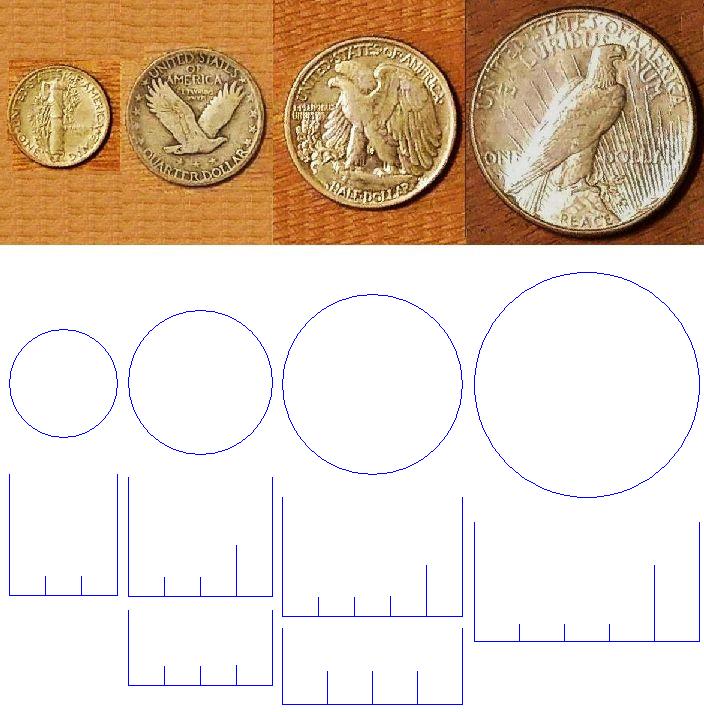
shows how the United States silver coins from the older type series - a 1941 Mercury Dime, a 1930 S Standing Liberty Quarter, a 1943 Walking Liberty Half Dollar, and a 1926 S Peace Dollar - compare in relative sizes to these proportions.
Here is a similar diagram, using images of U.S. gold coins, this time from a source published without a copyright notice prior to 1978, as I don't have those in my personal collection:
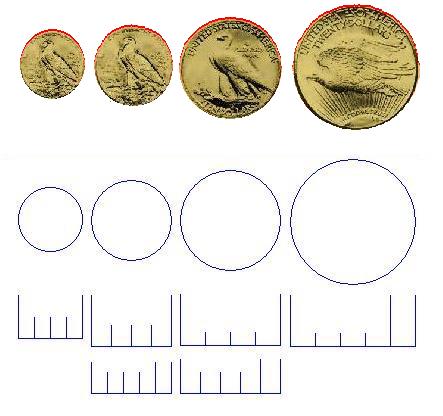
again, the images are scaled according to the diameters of the actual coins, while the circles are scaled to match one of the coins, and to show how applying the approximation for how coin diameters vary according to denomination compares to the coins.
And here is another similar diagram, this time using a source published prior to 1964, without a record of copyright renewal - and also without a copyright notice - for the more extensive series of sizes of Mexican gold coins:
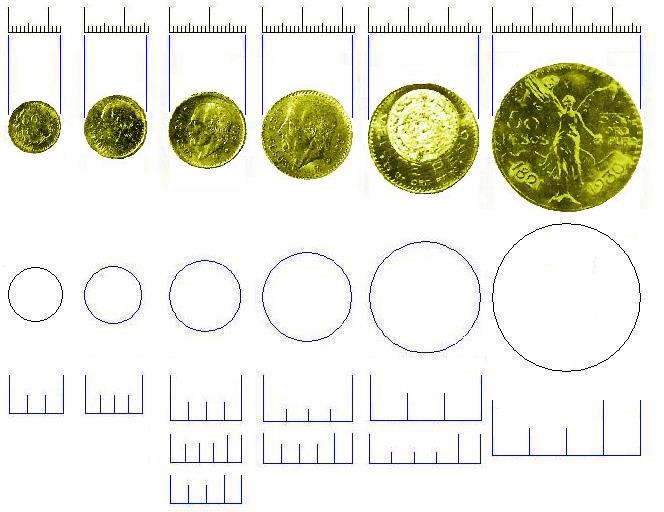
This time, a scale of millimetres is also shown above each coin, to show their actual sizes as well.
Incidentally, for comparison, 1 1/16" is 26.9875 inches, very close to 27 mm, a popular size, and 15/16" is 23.8125 mm, close to the size of a Canadian quarter. As well, .85" is 21.59 mm, and 1.06" is 26.924 mm, and .93" is 23.622 mm, and so the sizes of some coins may be explained by them being defined in inches rather than metric units.
The United States minted both a silver three-cent piece, which had a 14 mm diameter, called the "trine", and a larger cupro-nickel three-cent piece; as the silver five-cent piece was always referred to as a "half dime", I initially had trouble finding information about it in web searches.
The ideal size for a coin would seem to be something close to the size of a quarter, but a coin the size of a sixpence (about the size of a cent, or a 12 1/2 cent silver coin) or a nickel or a threepence (about the diameter of a 20 cent silver coin) is also within the ideal range.
Given that, the large difference in value between gold and silver creates a problem. Although coin denominations tend to advance in the ratio 1:2 or 1:2.5, a gap with a ratio of 1:5 is not unreasonable; thus, there was no two-cent coin.
To limit the gap to this size, a silver fifty-cent coin and a gold coin with a value of $2 or $2.50, both outside the ideal range, would be required, and at least one of those two would be needed even to limit the gap to a 1:10 ratio.
A number of solutions are possible. A coin with 25 cents worth of silver, and 75 cents worth of gold in a small dot in the center could be made. Or a 50-cent coin that is almost twice as thich as a quarter, so that its diameter is only as much larger than that of the quarter as needed to avoid confusion; perhaps around 26.5 mm, the diameter of the Canadian "loonie", and the American Susan B. Anthony dollar.
Initially, when most ordinary United States coins changed from being made of .900 fine silver to copper clad with cupronickel, the Kennedy half dollar continued to be made of silver, but with a reduced silver content.
The core of the coin was made of 21% silver, high enough to still be attractive in appearance; the cladding was 80% silver, the purity used for Canadian silver coins.
The coin's overall silver content was 40% silver.
A little algebra lets us determine that this means that the cladding made up 19/59ths of the coin's thickness, and the rest of the coin the other 40/59ths of the coin's thickness; or, rather, it would have if copper wasn't less dense than silver.
Even with a 16 to 1 ratio in the values of gold and silver, never mind a 78 to 1 ratio, the gap between the silver quarter and the gold half-eagle is a large one, that has to be filled either with inconveniently large silver coins, like the 50 cent piece, or inconveniently small gold coins, like the quarter eagle.
In the real world, this had never been a problem; the next stop after the quarter, in practice, was the one dollar bill; gold coins were only infrequently used for foreign exchange transactions involving banks or tourists.
Imagine, however, a coin with an inner layer of the usual silver coinage alloy, and cladding of the usual gold coinage alloy - using the 19/59 and 40/59 proportions of the Kennedy half dollar. Based on the 16 to 1 ratio, overall, the coin's metallic content would be worth about 5.83 times as much as silver. Note that the gold layer would actually be thinner than the .800 fine silver layer in the Kennedy half in proportion, since the difference in density between the two materials is greater; the calculation should have been based on volume, not weight.
Assuming, then, a coin which, by weight, is worth six times as much as a silver coin. And one wishes to give it the value of one dollar. So it would be the same size as a silver coin with a value of 16 2/3 cents.
A ten cent silver coin is the size of a dime, which is uncomfortably small, but one worth 12 1/2 cents is the size of a sixpence, or about the same diameter as a one-cent piece, which is comfortable, so such a coin could indeed be practical - assuming the cost of the cladding operation is not excessive, since presumably it would be a low-tech society that avoided paper money - and the method doesn't lend itself to counterfeit coins with a cheaper metal on the inside. (While gold is denser than lead, silver is less dense than lead; but lead is less electrically conductive than both of them.)
A $2 coin would be easier to achieve; a gold coin with $1.75 worth of metal could be placed in the center of an enclosing coin of silver with 25 cents worth of metal, the result being larger than a quarter, but designed so the gold coin is firmly held in place, while being visible on all sides.
Coins have been made of an alloy of 10% silver and 90% copper. As they do not remain attractive in appearance, doing something similar with a gold coin does not seem like a reasonable alternative, although the ancient Greeks made coins of electrum, a gold and silver alloy, usually about 40% gold and 60% silver. And, of course, 10 karat gold can be used in jewellery.
To put this in perspective, though, let us consider the current case, where the ratio between gold and silver is not 16:1, but 80:1. If one were to go back on the gold standard, so that in terms of the new dollar, the quarter eagle, half eagle, eagle, and double eagle returned, then the silver dollar would be a 20 cent coin, the half dollar a 10 cent coin, the quarter a 5 cent coin, and the dime a 2 cent coin. So now the gap would be between a large 20 cent coin and a small $2.50 coin.
Presumably, instead of a 2 cent dime, one would have a 25 mill sixpence, with the dollar being divided into 1000 mills instead of 100 cents.
If, instead, the price of silver were used as the basis of revaluing the currency, then the double eagle would be a $100 coin, the eagle a $50 coin, and either the half eagle would be a $25 coin, or there would be a $20 coin the size an old $4 coin would have had (the $4 Stella, at 22 mm, was actually larger than the $5 Half Eagle at 21.6 mm; I'm thinking of something about 20.3 mm in diameter), and perhaps a small $10 coin the size of an old $2 coin.
But going back to a standard of gold and silver coinage at this time is clearly a fantasy, given the current volatility of precious metal prices. Also, it has been noted that the size of the world's economic activity, as reflected in GNP and GDP, relative to the value of the world's monetary stock of gold, is vastly higher than it was in the days of the gold standard. That, however, may be less significant than it seems, as it may simply reflect a move away from the use of gold to back currencies; I would be interested in knowing about the size of the world's total stock of gold, non-monetary as well as monetary.
I have learned that one metal, ruthenium, has a price that is intermediate between that of gold and silver. Its current price is about 25 times that of silver, rather than 16 times, but that would still seem to allow it to serve the purpose of allowing coins to be made which would fill the gap between gold and silver at their current prices.
However, there are two possible problems. Ruthenium is not less valuable than platinum or palladium because it is less rare than those metals, quite the contrary. It is only less valuable because it has fewer industrial uses than they do. If it became widely used in coinage, that would increase the demand for it immensely.
Also, an oxide of ruthenium is highly toxic; however, that oxide is not something that forms normally, so this may not be an issue.
Because gold is denser than silver, if its value were 16 times as much as that of silver by weight, it would be about 25 times as valuable as silver by volume. Ruthenium being a platinum-group metal, I expected it to be about as dense.
However, it turns out that while the density of silver is 10.49 grams per cubic centimeter, and that of gold is 19.32 grams per cubic centimeter, a ratio of about 1.84 (so gold is actually closer to 29 1/2 times as valuable as silver by volume), the density of ruthenium is 12.2 grams per cubic centimeter, only a modest amount, a ratio of 1.16, more than that of silver, hence if ruthenium is 25 times as valuable as silver by weight, it is about 29 times as valuable as silver by volume.
So ruthenium coins, in relation to silver coins, could be exactly the same size as classic gold coins; they would not have to be 56% larger in volume, as I had originally been expecting.
This would make ruthenium an excellent replacement for gold in making commemorative coin sets which honor former gold and silver coinages.
A web search initially led me to think that ruthenium coins might already be a thing, but instead it turns out that what are called "black ruthenium coins" are silver coins that are plated with ruthenium, and, often, also with gold. And it turns out that ruthenium, unlike platinum and palladium, which are the usual "silvery" color of most metals, even such humble ones as nickel and tin, is dark in color. Is this why Chessex, in its line of metallic RPG dice, included a "dark metal" color in addition to the colors of copper, gold, and silver?
On further reflection, it's obviously iron, or more specifically, ferric oxide, that is most likely to be the inspiration.
Because copper or bronze coins tend to be token coinage, their size is quite variable; the value ratio of 20:1 for gold and silver at the same diameter is consistent, but that between silver and copper can vary from 25:1 to 50:1.
The density of gold is 19.32 grams per cubic centimetre, that of silver 10.49 grams/cc, that of copper 8.96 grams/cc. A ratio of 64:1 in value by weight would lead to a ratio of 75:1 in value by volume for silver and copper as metals. Copper coins tend, however, to be a token currency, that is, a metal form of paper money as it were, and so the ratio in weight of copper coin to silver coin would be more like 16:1 or 32:1.
The word "dollar", of course, is derived from "thaler", and the first thaler was the Joachimsthaler, originally minted in 1725. From it was derived the Reichsthaler of the Holy Roman Empire, used from 1566 to 1750, almost 200 years, with a silver content of 400.99 grains. (A Maria Theresa thaler, a trade coin deriving from this, contains 360.96 grains of silver, and is 0.833 fine.)
The value of silver, however, had a tendency to fall relative to the value of gold. Thus, an early attempt to establish a relationship between some gold coins and the thaler ended up requiring a readjustment: a Gulden, intended to be worth 72 Kreutzer, ended up having a value of 75 Kreutzer instead.
In Austria, the Gulden was intended to be equivalent to the Florin, which was worth 60 Kreutzer; the Austrian monetary system worked like this:
One Kreutzer was divided into 4 Pfenning or 8 Heller.
One Florin was divided into 60 Kreutzer.
One Thaler was divided into 2 Florin.
In northern Germany, some of the units of currency had the same names, but the system was different:
One Groschen was divided into 12 Pfenning or 24 Heller.
One Thaler was divided into 24 Groschen.
A gold coin contemporary with the thaler that was stable in metallic content was the Ducat as issued by Hungary; it continued to contain 3.53133 grams of 0.986 fine gold for a long period, from 1311 to 1915. This would be 53.738 grains of fine gold.
If gold is worth 16 times as much as silver, a ducat would be 2.14 thalers; if gold were worth 15.5 times as much as silver, a ducat would be worth 2.08 thalers.
So, if one accepts that the value given to silver was over-optimistic, one could define the ur-dollar as being the value of one-half ducat, or 26.869 grains of gold.
But that is one of only two possible candidates for the original value of the dollar.
The first currency in the world that was decimal like the dollar, divided into 100 smaller units, was the ruble of Russia, divided into 100 kopeks. And it was close to a dollar in value. This was created by Peter the Great in 1704, with a 28 gram ruble of 0.875 fine silver being equivalent to 100 copper kopeks. Gold coins were later produced on the basis that gold was worth 15 times as much as silver, and so if we use that to define the value of the ruble, given that gold is usually worth more than 15 times as much as silver, a ruble becomes the value of 1.63333... grams of gold, or about 25.2061853098 grains of gold.
And if we use the specifications of the pre-1933 U.S. coinage in a simplistic way, by ignoring the value of the alloying metals, we get 23.22 grains of gold being equal to a dollar. Since 26.87 and even 25.2 are sufficiently larger than that to be unfamiliar and remote, using either as the basis for a new dollar is not appealing. (Even the value of the U.S. dollar in terms of gold used prior to 1834 would only lead to a value of 24.77 grains, still smaller than the amounts based on the ruble or the ducat.)
However, looking at actual Russian gold coins, we can see how the value of the Ruble changed over the centuries.
For example, the 10 Ruble gold coin, starting from 1755 went like this:
Fine Gold Versus U.S.
Grams Gold Eagle
1755 - 1763 16.59 grams 0.917 fine 15.21303 1.01108
1764 - 1796 13.08 grams 0.917 fine 11.99436 0.79716
1802 - 1805 12.17 grams 0.986 fine 11.99962 0.79751
1886 - 1894 12.9039 grams 0.900 fine 11.61351 0.77185 (40 Francs 28 4/5 Kronor)
1898 - 1911 8.6026 grams 0.900 fine 7.74234 0.51457 (26 2/3 Francs 19 1/5 Kronor)
So instead of being quite a bit larger than a dollar at the beginning, the Ruble was about $1.01 near the beginning, and gradually lost value over time. Incidentally, in 1923 and 1925, the R.F.S.F.R. issued a 10 Ruble coin, the Chervonets, with the same weight and fineness as the 1898-1911 Imperial Ruble, for purposes of trade.
The 2 Ruble gold coin was minted earlier, allowing an additional basis of comparison:
Fine Gold
Grams
1718 - 1725 4.1 grams 0.781 fine 3.2021
1726 - 1728 3.47 grams 0.781 fine 2.71007
1756 3.24 grams 0.917 fine 2.97108
1766 2.61 grams 0.917 fine 2.39337
1785 - 1786 2.62 grams 0.917 fine 2.40254
which gives a value of 1.06408 times the U.S. dollar (from 1834 to 1933) for the Ruble in the 1718-1725 period. As the U.S. dollar prior to 1834 was worth $1.07 in terms of the U.S. dollar afterwards, this implies that the decimal Ruble started out at a value very close to that of the U.S. dollar.
Peter the Great redefined Russia's traditional units of measurement in terms of the British Imperial units of measure. Thus, the Dyuym was defined to be exactly one inch in lenth, and the Russian Fut was defined to be exactly one foot in length. However, the Vershok was 1 3/4 inches, and the Pyad was 7 inches, and the Arshin was 28 inches, so Russian units of length did not slavishly follow the British Imperial system.
Russian units of weight, like those in the British Imperial system, had both an ordinary system, corresponding to the avoirdupois weight of the British Imperial system, and an apothecaries' system, corresponding to the troy weight of the British Imperial system.
These units do not appear to have been altered as radically as the units of length were, as although they may be defined in terms of the British Imperial system, they are not round numbers within it.
In the ordinary system, there are 96 Dolya in one Zolotnik, 3 Zolotnik in one Lot, and 32 Lot in a Funt. A Pood is 40 Funt, and a Berkovets is 10 Pood. The Dolya is equal to 0.686 grains in the British Imperial system, and so a Lot is approximately 0.451 ounces and a Funt is approximately 0.903 pounds.
The apothecaries' system is more simply related to the ordinary system than avoirdupois weight and troy weight are related in the British Imperial system.
The basis of the apothecaries' system is the Gran, which is equal to 1.4 Dolya from the ordinary system, and which is equal to 0.96004 grains.
A Scrupul is 20 Gran, a Drakhma is three Scrupul or 60 Gran, an Untsiya is eight Drakhma or 480 Gran, and a Funt is 5760 Gran or twelve Untsiya.
Therefore, not only is a Gran equal to 0.96004 grains, but an Untsiya is equal to 0.96004 troy ounces, and a Funt is equal to 0.96004 troy pounds.
From 1764 to 1805, we see in the table above that a ruble was about equal to 1.2 grams; but rather than being defined in terms of the gram, it was defined as the value of 27 Dolya of pure gold, and so these units of weight are relevant to the Russian gold standard.
A grain is exactly 0.06479891 grams as a result of the avoirdupois pound, which is 7000 grains, being defined as 453.59237 grams, and so the Dolya is 0.04445205226 grams. 27 Dolya are 1.20020541102 grams, or 18.522 grains.
The 1886 to 1894 period reflects a gold standard which was proclaimed on December 17th, 1885, where the Ruble was defined as 1.161 grams of pure gold, and, presumably, as 26.136 Dolya of pure gold, given the ratio between 4 Francs and 2 2/3 Francs.
In the 1898 to 1911 period, where the Ruble was defined as 2 2/3 Francs, the Ruble was defined as 17.424 Dolya or 0.77424 grams of pure gold.
Over the same span of time, the 1 Ruble silver coin followed this course:
Fine Silver Gold:Silver
Grams Ratio
1734 - 1762 25.85 grams 0.8020 fine 20.7317 13.627594 : 1 (1755-1762)
1762 - 1796 24 grams 0.7500 fine 18 15.007053 : 1 (1764-1796)
1801 - 1885 20.73 grams 0.8680 fine 17.99364 14.995175 : 1 (1802-1805)
1886 - 1894 19.996 grams 0.900 fine 17.9964 15.496090 : 1 (1886-1894)
1901 - 1914 20.000 grams 0.900 fine 18 23.248785 : 1 (1901-1911)
So apparently the gold/silver ratio went from 13.6:1 to 15:1 to 15.5 to 1 to 23.25 to 1 over the span of history covered here. However, that last figure seems odd. Yet, in 1924, the Soviet Union also issued a silver 1 Ruble coin that was also 20 grams of 0.900 fine silver.
I had been surprised by the high ratio of gold to silver, allowing for extra-large silver coins, but then I looked at data for the historic ratio of the prices of those metals, and saw that before 1968, when the world was still on the gold standard, the ratio had been as high as the current 80:1 ratio; but back then, this was percieved as the price of silver being low, instead of the price of gold being high.
Incidentally, starting in 1867, the 10, 15, and 20 Kopek coins were made from 0.500 fine silver, while the 25 and 50 Kopek coins continued to have the same composition as the silver Ruble. The silver 5 Kopek coin was also made of 0.500 fine silver when it began to be minted again in 1901.
Just as in Canada and the United States, we refer to the 5-cent piece as a nickel, the 10-cent piece as a dime, and the 25-cent piece as a quarter, and in the United States, in addition, a 10 dollar coin was called an Eagle, and a 100 dollar coin was called a Union, the Russians also have special names for some of their coins:
Denomination ¼ Kopek Полушка Polushka ½ Kopek Деньга Denga Kopek Копѣйка Копейка 3 Kopeks Алтынъ Алтын Altyn 10 Kopeks Гривенникъ Гривенник Grivennik 25 Kopeks Полуполтинникъ Полуполтинник Polupoltinnik 50 Kopeks Полтина Poltina Ruble Рубль
Where, in some cases, two versions of the Russian name are given, the second one is the spelling in the "New Orthography", brought into effect in the Soviet Union shortly after it was proposed on May 11, 1917.
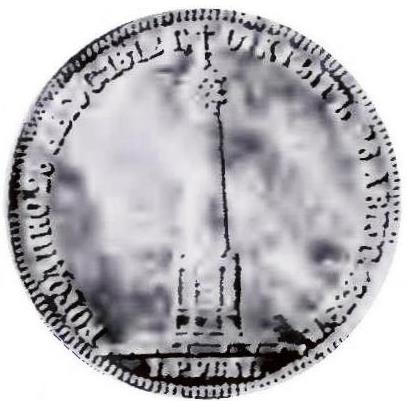
The slow decline of the value of the Russian ruble under the czars, of course, is nothing compared to what happened in the Soviet Union: in 1923, one new ruble was equal to 1,000,000 old rubles, and then in 1924, one new ruble was equal to 50,000 old rubles, in 1947, one new ruble was equal to 10 old rubles, and in 1961 one new ruble was again equal to 10 old rubles.
After the fall of the Soviet Union, in 1998, one new ruble was equal to 1,000 old rubles, and it is this ruble that fell in value from about two cents to about one cent due to the international reaction to the Russian invasion of Ukraine which began on February 24, 2022.
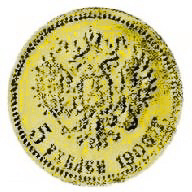
Thus, the Russian Ruble, once a large and handsome silver coin, and, indeed, of such value that the five-ruble coin was made of gold, is brought to utter ignominy through about a century of misrule, with one ruble of the present day being defined as 5,000,000,000,000,000 old rubles prior to 1923. At least it remained in continuous existence.
Another example of the silver one-ruble coin of Imperial Russia is shown below:
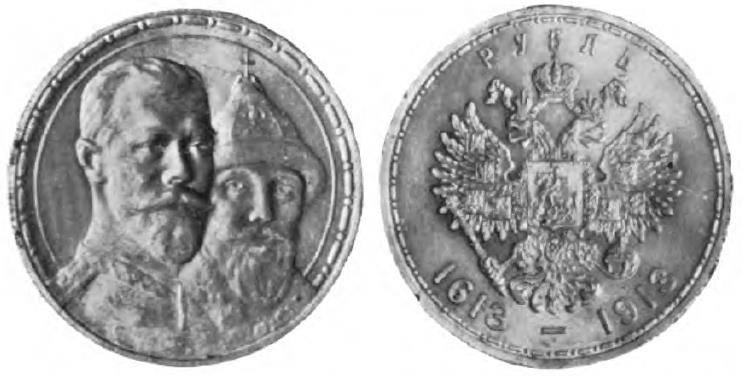
It commemorates the 300th anniversary of the Romanov dynasty. Thus, the obverse of the coin, shown on the left of the image, shows the current (in 1913, when the coin was minted) czar, Nicholas II, and a ghostly figure behind him. But that figure is not that of the founder of the Romanov dynasty, Mikhail I, as one might expect from the purpose of the coin. Instead, it is that of Boris Godunov, an earlier leader of Russia, who took over from Ivan the Terrible, the last of the Rurik czars.
The Rurik dynasty dates from the time of Kievan Rus'. But that doesn't necessarily mean that Ivan the Terrible was Ukrainian; on the other hand, it is definitely the case that Stalin, whose family name was Djugashvili, was Georgian. Are the Russians out for revenge, or do they want to reunite these areas with Russia so as to have a future supply of poor leadership?
For that matter, if I'm going to talk about politics...
In 1876, on the 100th anniversary of the founding of the United States of America with the Declaration of Independence on July 4, 1776, no commemorative coins were issued.
The Bicentennial, in 1976, was celebrated with a commemorative quarter, half dollar, and dollar... over the objections of the U.S. Treasury.
In 1926, more than one commemorative coin was issued to celebrate the Sesquicentennial; one of them was unique:
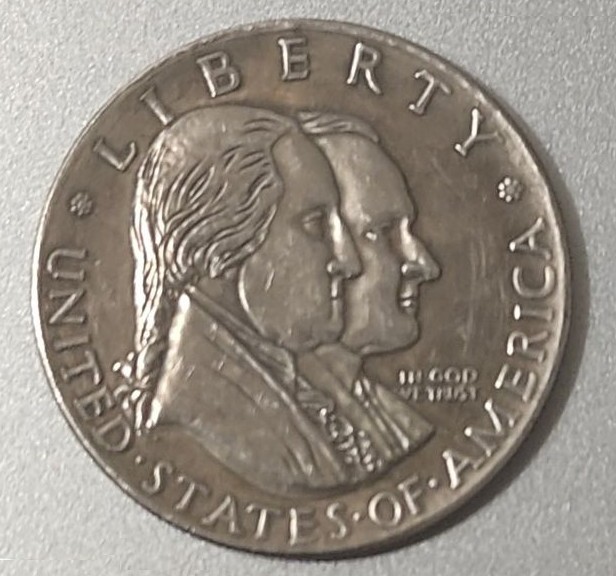

This one shows, on the obverse or "heads" side, George Washington in the foreground, and Calvin Coolidge in the background. This may have been controversial, since Calvin Coolidge, the sitting President at the time, was still among the living. A few other living people have appeared on U.S. coins, including one astronaut; although legislation has prohibited the depiction of living people on U.S. coins, this legislation only apparently referred to specific coin issues rather than enshrining this long-standing convention into law for all U.S. coins.
This coin came to my mind given a certain news item concerning the 250th anniversary of the Declaration of Independence, which is coming next year.
As for Boris Godunov, since the Russians don't call him Boris the Terrible, I can only assume that he was an improvement. However, his reign was marred by one lapse of judgment; perhaps in order to prevent peasants from being swindled out of their land, he decreed that they could no longer sell or trade it (up till then, they could do so, but only on one special day in the year). This ultimately led to the institution of serfdom in Russia. Everywhere else, peasants own the small plots of land they farm, until some form of "social progress" gives that land to great lords, so that they stop being peasants, but in Russia, land owns you.
Boris Godunov was a Tatar, but I don't think that really explains the invasion of Crimea, simply to complete the set of sources of Russian leaders. The obvious reason, its use as a naval port when Vladivostok gets frozen in, is clearly the real one.
Incidentally, the artist Nicholas Roerich got his last name from a father of German ethnic origin, so his descendants are not potential Russian monarchs by right of descent.
Boris Godunov was the subject of a famous play by Aleksandr Pushkin, and was thus well enough known that the makers of The Rocky and Bullwinkle Show were confident that at least many adults would get the joke when a villainous spy and saboteur that Rocky and Bullwinkle often had to foil was named Boris Badenough.
A third candidate for an ur-dollar, however, has come to my awareness.
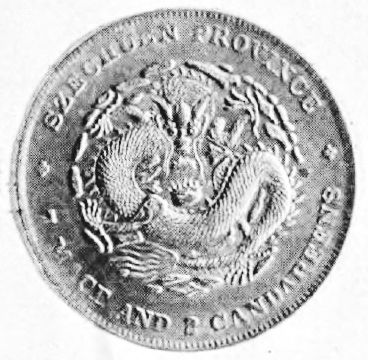
Some Chinese coins bear on them the legend "7 Mace, 2 Candareens"; an image of one such coin is shown on the right. I thought that perhaps these were trade dollars, and so they gave their value also in the currency of India or somewhere. But, in fact, that was not the case.
China also had its own decimal system of currency. The Tael was divided into 10 Mace, and each Mace was divided into 10 Candareens.
But it later adopted, and eventually switched to, a different unit of currency, the Yuan, which was also divided decimally; a Yuan was 10 Jiao, and a Jiao was 10 Fen. And a Yuan was also equivalent to 7 Mace and 2 Candareens - or 72 Candareens, or 0.72 Tael.
The Cash, in which the Chinese round coins with square holes were denominated, was nominally one-tenth of a Candareen, and then changed to one-tenth of a Fen, but its value declined relative to the silver-based currency, thus one reference notes that in 1874, the value of the Cash declined so that there were 4,000 Cash to a Tael.
The original value of a Yuan was close to that of a U.S. dollar; but it wasn't adopted due to the influence of the United States. Instead, China independently created the Yuan, with its particular value, for the same reason that the United States chose to have a dollar with the value originally assigned to it.
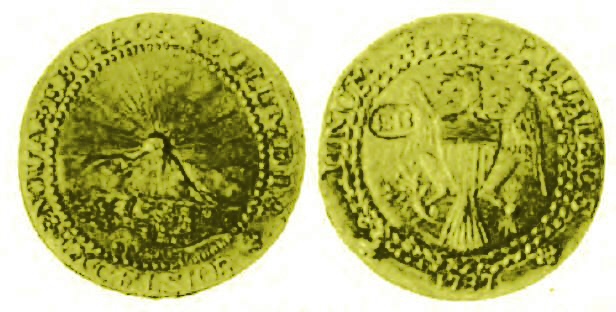
Both currency units were based on... the Spanish 8 Real coin. Arrr indeed.
And we mustn't forget that because, in those old times when people were isolated and had to make do, people took Spanish dollars and cut them into eight pieces, using each one as a one-Real coin, which English speakers colloquially refered to as bits, that people came to refer to a quarter as "two bits" in the present day.
The gold Doubloon, another Spanish coin of that time, was in the denomination of 2 Escudos, with each Escudo being worth about two dollars - but the value of the Escudo depended on the price of gold, while the value of the Real depended on the price of silver. (Incidentally, at least at the time, the term "Doubloon" was instead applied to gold coins of 4 Escudos or 8 Escudos in some places. Thus, the famous "Brasher Doubloon", one of the rarest U.S. coins in existence, which is shown on the left, was a coin worth $16 at the time, being of the 8 Escudo size.)
Thus, to determine a value for the dollar, the Escudo, 3.383 grams of 0.875 fine gold, is more applicable; half of that is 1.6915 grams of 0.875 fine gold, the same, except for rounding error, as the 1870 peso of 1.692 grams of 0.875 fine gold noted above, worth about 98.4 cents in terms of the pre-1933 U.S. dollar. Thus, instead of being disappointed that the Mexican peso was slightly below the value of a U.S. dollar when it was originally at its highest value, one might instead be pleased that it so closely approximates the value of the original Spanish gold coins on which the U.S. dollar and the Chinese yuan were also based.
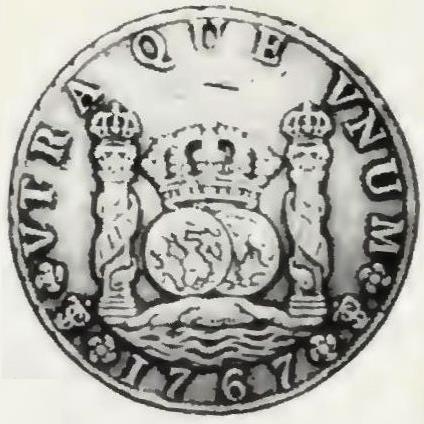
Shown on the right is one style used for pieces of eight; the pillar on the right, with a ribbon or banner wrapped around it is thought by some to be the origin of the dollar sign, $, used to denote the dollar or the peso. Originally a Spanish coin minted during the reign of Philip V, coins in this style continued to be minted in Spain under Charles III, and were also minted in Bolivia. Also, this design was used for coins that were 4 Reales, 2 Reales, one Real, and even 1/2 Real in denomination as well; half dollars and quarter dollars, and I suppose one could say sixpence and threepence.
There are several other theories of the origin of the dollar sign. I will just mention two. The one most favored by historians is that the Spanish peso was often referred to by the abbreviation Ps, and in handwriting, one representation of this abbreviation came to resemble the dollar sign. This is the theory advanced by Florian Cajori in his book A History of Mathematical Notations.
But another theory has better actual evidence supporting it, in at least one regard. In English, one of the meanings of the word "cipher" is the digit zero. In Portuguese, the cognate word cifrão instead refers to a symbol used either as a decimal point, or to mark off thousands from units, and that symbol has the form of a dollar sign with two vertical strokes.
In the early part of the 19th century, it was used in this fashion: an amount of money written as 1:390$500 would be 1,390 milreis and 500 reis. So the cifrão would act like a comma to separate thousands from units, but the colon performs the function of the comma for separating millions from thousands.
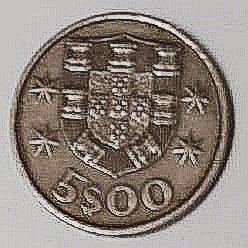
In a series of Portuguese coins minted during the 1950s and 1960s, on the other hand, the cifrão acts as a decimal point, with 2$50 representing 2½ escudos or 2 escudos and 50 centavos. A five-escudo coin from that series is pictured at left.
There are examples of its use dating as far back as 1544, according to an article appearing in the September 1914 issue of The Numismatist. This article is credited to the newspaper The New York Independent. But its origin is said to go back even further; from an S-shaped symbol on a coin issued for Tariq ibn Ziyad to commemorate his conquest of the Iberian peninsula which began in the year 711.
A site in the English language credits the web site of Brazil's central bank for this version of the story: the S-shape represented Tariq ibn Ziyad's ocean voyage to Gibraltar, and it was crossed by two lines representing the pillars of Hercules. Perhaps it is only my lack of understanding of the Portuguese language, but when I previously visited the site of the Brazilian mint, what I thought it said was that the S shape represented Tariq ibn Ziyad's route on land from city to city within what is now Spain and Portugal on his conquest - and it was only an S, without lines crossing it.
Neither one has a picture of the coin in question, for which I have been looking online.
In a paper in the September 1929 issue of The Scientific Monthly by Florian Cajori (which notes that it concerns additional information on the history of the dollar sign, subsequent to that in his earlier papers on the subject, which was summarized in his book A History of Mathematical Notations) mentions the cifrão, but notes that there is no evidence of contact between the United States and Portugal through which that symbol inspired that for the U.S. dollar.
The question immediately occured to me of whether or not there was contact between Spain and Portugal, by means of which the cifrão could have inspired the symbol for the Spanish peso, which then subsequently inspired the dollar sign; after all, Spain and Portugal, and Brazil and many Spanish-speaking countries in Latin America, do share a border. Apparently, however, there is no direct written record of that happening, and there is evidence of the Ps monogram gradually becoming the $ symbol with one vertical bar, which Dr. Cajori cites, and in some cases reproduces, in that paper.
And another point is made: the form of the abbreviation for "peso", Ps, places the S above the P, whereas it needs to be below the P for the stem of the P to go through the center of the S. Thus, the handwritten examples of a monogram for the Peso becoming the dollar sign come from the English-speaking world, from which the dollar sign (used to refer, initially, to the Spanish peso) then entered Mexico and other Spanish-speaking countries, it is claimed.

In looking up information about the history of the dollar sign, I learned that the first printed book in the United States which used the symbol was The American Accomptant by Chauncey Lee, from 1797. However, as can be seen at left, the form of that symbol used in that book was different from that which is normally used today.
In fact, its form had a specific rationale, which was laid out in a section of the book which explained the symbols used within it. There was no explanation of the dollar sign itself, instead this was merely within an example in the explanation of the equals sign:

Thus, if one replaces the doubled S portion of the symbol by a single S, one has a symbol for dimes; omit the S, and just have two slashes, and it's a cents symbol, and finally a single slash is the symbol for mills, a mill being one-tenth of a cent.
The Portuguese cifrão appears to have had multiple forms, although this may have been due to errors in foreign descriptions of it.
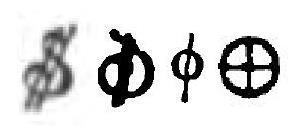
In the image above, we see first the cifrão in the typeface used for an official document of the Portuguese government.
The second symbol appears to have been a cifrão, but used alone without any digits to indicate a zero entry in a ledger, in an old Portuguese book on arithmetic. It is somewhat simplified, with a single stroke, and the top part of the S omitted.
The third symbol is given as an alternate form of the cifrão in a French book on accounting arithmetic in the nineteenth century. The final symbol appears as an alternate to the third in another French book, and as the only form of the cifrão shown in an English book on arithmetic and exchange for mariners.
The style of cifrão shown as the second symbol in the diagram above could be mistaken for a zero with a stroke through it, as the diagram below illustrates:
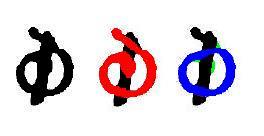
When I enlarged that symbol for the preceding diagram, I saw that it had the structure shown in the second version of the symbol, with a partial S indicated in red. But when I had seen it originally, I thought the symbol had the structure in the second part, with the circle indicated in blue; ignoring the parts shown in green as random ink splotches, as the original document from which it came looked like this without magnification:
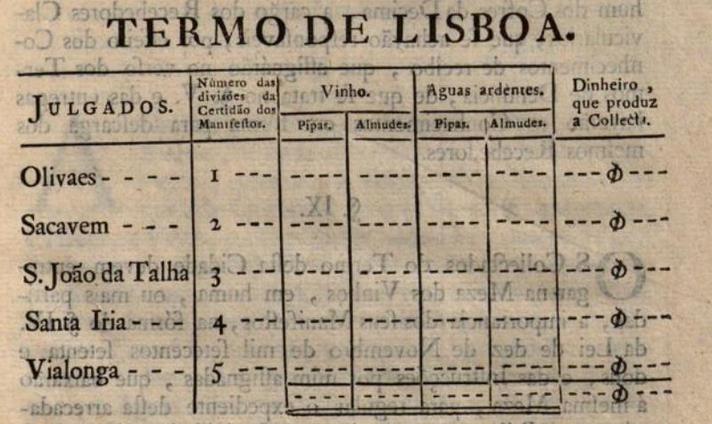
As noted above, the U.S. dollar was originally defined as the value of 371.25 grains of fine silver. As the Chinese tael was 1 1/3 avoirdupois ounces, that would make it 583 1/3 grains of fine silver, and so the original value of the Chinese yuan would be 72% of that, or 420 grains of fine silver. As a Joachimsthaler was worth 451 grains of silver, this value wasn't outside the range of dollar coins, but the Tael could have undergone inflation; around the time that the Yuan was first adopted, the 8 Reales coins in common international use were minted in Mexico, following the established Spanish standard of weight and fineness, and they contained about 24.4388 grams of fine silver, or 377.15 grains. I thought it might have been that when the Chinese yuan was introduced, a Tael was the value of 37.5 grams of silver, since 37.5 grams is the value of the Tael as a unit of weight, and thus a Yuan was the value of 27 grams of silver, or 416.67 grains of silver; and it does appear that the early issues of coins in the denomination of 1 Yuan were in a range of weights that included that value.
As for the origin of the British pound, the system of pounds, shillings, and pence originated with Charlemagne.
A pound of pure silver, with a veight of 489.6 grams, had the value of a libra, with the solidus being the twentieth part of a libra, and the denarius being the twelfth part of a solidus.
The British Pound and the French Franc started out as having the value of a Carolingian libra, and many other European currencies began this way.
Whether or not the avoirdupois pound is a unit of force instead of a unit of mass, the troy ounce is definitely a unit of mass.
The kilogram is a unit of mass, and the metric unit of force is the Newton, which is the force required to accelerate a mass of one kilogram to a velocity of one metre per second in a second, thus it has the dimensions of one kilogram per metre squared.
It was more common to measure forces in terms of kilograms of force, based on a standard for the acceleration of the Earth's gravity of 9.80665 metres/second2, which means that a kilogram of force is equal to 9.80665 Newtons. This is based on the intensity of gravity, less the centrifugal force of the Earth's rotation, in Paris.
As the pound may be a unit of force (in the British unit of energy, the foot-pound), or a unit of mass, it has two companion units.
A slug is 32.174049 pounds of mass, and a pound of force is 32.174049 poundals.
This is based on an acceleration of gravity of 32.174049 feet per second squared; that many feet is 9.8066501352 metres, so that figure was clearly derived from the metric standard. However, I have also seen references that gave 32.174 exactly as the relation between pounds-force and poundals as well as slugs and pounds-mass; a different standard gravity, say that felt around London, could have been used for the British system.
In addition to the troy ounce, there were other alternative pounds used in Britain. Thus, the Tower pound was twelve Tower ounces, the Tower ounce being 15/16ths of a Troy ounce, or 450 grains. As well, a Merchant pound was 15 Tower ounces (6750 grains), and a London pound was 16 Tower ounces or 15 Troy ounces (7200 grains). Naturally, these units, being liable to cause confusion, tended to fall into disuse.
The Tower pound does have some historical significance. Prior to 1528 (!) the pound sterling was a Tower pound rather than a Troy pound of sterling (0.925 fine) silver; the Tower pound was originally established to be the weight of 120 silver dirhems, a coin from Arabia. Thus, while the British system of weights and measures largely, like most other European pre-metric systems of measurements, derives from that of ancient Rome, the fundamental standard on which the exact value of British weights were based came from Arabia.
Incidentally, when I note that the Avoirdupois pound is defined as 7000 grains, while the Troy ounce is defined as 480 grains, in both cases I am using the same grain, the troy grain. However, while there is no such thing as an Avoirdupois grain, there is also a Tower grain; so while a Tower ounce is 450 Troy grains, it is 640 Tower grains.
This would lead to the dirhem being defined as 45 Troy grains, or about 2.91595 grams. Incidentally, Wikipedia gives several modern values of the dirhem, 3.207 grams (the standard in the late Ottoman Empire), 3.088 grams (an Egyptian standard, defined as 47.661 Troy grains), and two modern proposals for reviving the dirham as a unit for measuring the weight of silver, 3 grams, and 2.975 grams, all heavier than the value preserved in the pound.
The name of the dirhem or dirham derives from that of the Greek drachma; in ancient Greece, a drachma was 4.3 grams of silver, and originally in modern coinage a drachma was 4.5 grams of 0.900 fine silver.
Gold and silver have been the principal coinage metals, with less expensive metals used principally for token coinage. These days, though, inflation has meant that a number of countries have taken copper and nickel out of their coins, switching to iron, the cheapest metal.
For example, in Canada, our coins changed in composition as follows:
The one-cent coin changed from being made from copper with a small admixture of tin and zinc to zinc plated with copper in 1997, and partly switched again to steel plated with copper in 2000, until being discontinued in 2012.
The five-cent coin was a tiny silver coin (92.5% silver up 1o 1919, 80% silver thereafter) until 1922, when it became a nickel coin, with occasional changes to chrome-plated steel or a copper-zinc alloy due to wartime scarcity during both World War II and the Korean conflict, until 1981. In 1982, it changed to being cupronickel, 75% copper and 25% nickel, like the U.S. nickel had been, and then in 2000 it became steel plated with nickel.
The other silver coins also changed from 92.5% silver to 80% silver in 1920; during 1967, the 10 cent piece and the 25 cent piece only changed to 50% silver, while the 50 cent piece and the silver dollar stayed at 80% silver, and during 1968 all the silver coins changed over to nickel.
The 10 cent piece, the 25 cent piece, and the 50 cent piece all changed from nickel to steel plated with nickel in 2000.
On the other hand, the one dollar coin of the "loonie" style (the same diameter as the Susan B. Anthony dollar, 26.5 mm, except for having a slightly larger diameter of 26.72mm on the year of its introduction), introduced in 1987, and the two dollar coin introduced in 1996 only switched from nickel to steel in 2012.
Today, as I write this, January 7, 2021, copper is worth about $4.50 a pound, while silver is about $22.50 per troy ounce. So silver is about 73 times as valuable as copper, which is not a departure from historical values - whereas the value of gold, compared to that of silver, is vastly higher than what had been the case historically.
The American nickel is made from cupronickel, 75% copper and 25% nickel. Many other countries have used this particular composition for their coinage.
Some early U.S. cents were of an alloy of 87.5% copper and 12.5% nickel, which is said to have been of a light yellow color.
The British three pence coin, made from nickel brass, had 79% copper, 20% zinc, and 1% nickel as its composition.
Alloys of copper, nickel, and zinc have been used, under the names "German silver", "Nickel silver", and "Alpacca", among others, to imitate silver in appearance. One such alloy apparently was 55% copper, 25% zinc, and 20% nickel.
I have been unable to find out what the exact composition of the aluminum bronze used in Argentine coins, such as the 5, 10, and 20 centavo coins from 1942 to 1950, which retained a bright yellow color even when no longer shiny.
Originally, the Canadian "toonie", a bimetallic $2 gold coin, had a pure nickel outer ring, and the golden-colored inner part was 92% copper, 6% aluminum, and 2% nickel, classed as a form of aluminum-bronze.
Nordic Gold has the composition of 89% copper, 5% aluminum, 5% zinc, and 1% tin, being intended as a metal resistant to tarnish with a golden color that avoids nickel, to which some people are allergic.
It was noted above that the Kennedy half dollar was composed of outer layers which were 80% silver and 20% copper, and an inner layer that was 21% silver and 79% copper.
In 1965, the other U.S. silver coins changed to a clad construction with the outer layers made of 25% nickel and 75% copper, the same cupronickel alloy as used for the nickel, and an inner layer of copper, designed to behave like the former 90% silver and 10% copper coins in vending machines.
Today, starting from 1999, the dime, quarter, and half dollar in the United States no longer have a clad construction, but are instead made of an alloy of 8.33% nickel and 91.67% copper; this made the proportions of the two metals the same as in the coins made of copper clad with cupronickel.
While Canada's current $1 coin has the same diameter as the American Susan B. Anthony dollar, while the Canadian coin was plated with brass to have a golden color, the Susan B. Anthony dollar had the same clad composition as the dime, the quarter, and the half dollar.
The Susan B. Anthony dollar was minted for the years 1979 through 1981, and then returned in 1999.
It was succeeded by a dollar coin of similar size which did have a golden color, to help prevent confusion with the quarter which was only slightly smaller, the Sacaweja dollar, minted from 2000 to 2016. Except for the first year of mintage, only small numbers were minted, as it was also unpopular.
So, while the Canadian loonie was only introduced in 1987, many years after the United States came out with the Susan B. Anthony dollar, Canada was first with the idea to give this type of coin a golden color to make it distinct from the quarter.
Overlapping with it were the Presidential dollars; they ran from 2007 to 2016; mintages were large from 2007 to 2011, and then in the remaining years, it was made only for collectors to complete their sets.
In 2018 the American Innovation dollar began to be minted. It is envisaged to continue to be minted until 2032. However, in recent news, the law preventing living persons from being depicted on American coins, postage stamps, and paper money may be amended so that the United States may celebrate the 250th anniversary of its founding with a gold-colored one dollar coin bearing the likeness of its current President, Donald J. Trump, on both the obverse and the reverse.